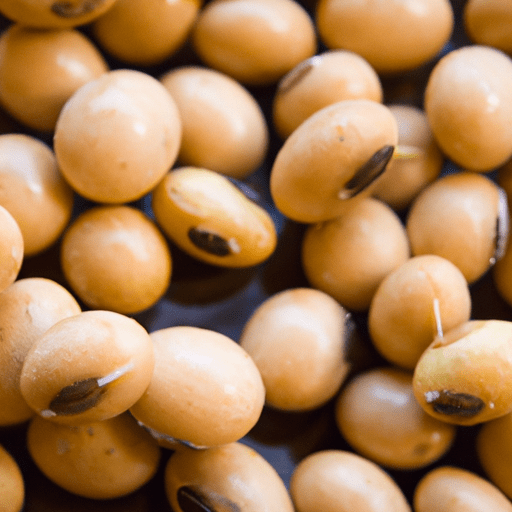Discover the Delights of Roasted Soybeans: A Nutritious and Flavorful Snack
Soybeans have long been hailed as a nutritional powerhouse, packed with essential nutrients and beneficial compounds. While they are often transformed into tofu, soy milk, and other soy-based products, roasted soybeans are a delightful and versatile alternative. In this blog post, we will delve into the world of roasted soybeans, exploring their taste, common uses in cooking, nutritional value, and even uncovering some intriguing historical and factual tidbits.
The Taste of Roasted Soybeans: Crispy, Nutty, and Satisfying
Roasted soybeans offer a unique sensory experience. When you bite into these little legumes, you’ll be greeted with a delightfully crisp texture and a burst of nutty flavor. The roasting process enhances the natural sweetness of the soybeans while adding a subtle depth to their profile. The result is an addictive snack that is both wholesome and satisfying.
Versatile Uses in Cooking: From Snacks to Seasonings
Roasted soybeans can elevate a myriad of culinary creations. These versatile legumes can be enjoyed on their own as a simple and nutritious snack. Packed with protein, fiber, and healthy fats, they make a satisfying and energy-boosting option for anyone looking for a guilt-free nibble.
Beyond snacking, roasted soybeans can also be used as a flavorful addition to various dishes. Crushed or ground, they can be sprinkled over salads, soups, and stir-fries, adding a delightful crunch and a dash of nuttiness. Alternatively, roasted soybeans can be ground into a fine powder and used as a seasoning or a substitute for breadcrumbs, giving a unique twist to your favorite recipes.
The Nutritional Powerhouse: A Wealth of Essential Nutrients
Roasted soybeans not only satisfy your taste buds but also nourish your body with an array of essential nutrients. They are an excellent source of plant-based protein, making them an ideal meat alternative for vegans and vegetarians. Additionally, soybeans are rich in dietary fiber, aiding digestion and promoting a healthy gut.
Moreover, roasted soybeans provide a significant dose of vitamins and minerals, including calcium, iron, magnesium, and potassium. These little legumes also contain beneficial antioxidants, such as isoflavones, which have been linked to various health benefits, including reduced cholesterol levels and improved heart health.
A Glimpse into Soybean’s History and Intriguing Facts
Soybeans have a fascinating history that can be traced back thousands of years. Originating in East Asia, they were first cultivated in China around 2000 BCE. Fast forward to today, soybeans have become one of the most widely grown and consumed crops worldwide.
Interestingly, soybeans were not always appreciated for their culinary merits. In Ancient China, they were primarily used for soil improvement and as fodder for livestock. It wasn’t until later that their incredible nutritional value and versatility were discovered, turning them into a staple ingredient in many cuisines around the world.
Another intriguing fact about soybeans is their diversity. You may have encountered different variations, such as edamame, which are young, green soybeans, or soy nuts, which are boiled and then roasted soybeans. Each variation offers a unique taste and culinary experience.
Conclusion
Roasted soybeans are a true delight for both your taste buds and your health. With their crispy texture, nutty flavor, and versatile uses in cooking, these little legumes are a worthy addition to any pantry. Whether you enjoy them as a nutritious snack or incorporate them into your favorite recipes, roasted soybeans offer a wealth of nutrients and a tantalizing culinary experience. So, why not give them a try and embark on a journey of flavor and well-being?
Roasted Soybeans
Origin: Soybeans, also known as Glycine max, are a species of legume native to East Asia. They have been cultivated in China for thousands of years and are an important part of the traditional Asian diet.
Common uses: Roasted soybeans, often called soy nuts, can be enjoyed as a snack on their own, or used as an ingredient in various recipes. They are commonly used as a topping for salads, added to trail mixes, or used in granola bars. Roasted soybeans can also be ground into flour and used in baking, or processed to make soy milk and tofu.
Nutritional benefits: Roasted soybeans are a nutrient-dense food. They are a complete protein source, containing all nine essential amino acids that the body needs. They are also a good source of dietary fiber, healthy fats, vitamins, and minerals. Roasted soybeans are especially rich in folate, iron, magnesium, and potassium.
Unique properties: Soybeans are one of the few plant-based protein sources that provide a complete protein profile, meaning they contain all the essential amino acids needed for human health. They are also a noteworthy source of phytochemicals, such as isoflavones, which act as antioxidants in the body.
Historical significance: Soybeans have been cultivated in China for over 5,000 years and have played a significant role in Chinese cuisine and traditional medicine. They were introduced to other regions of Asia, including Japan and Korea, where they also became staple foods. Over time, soybeans spread to various parts of the world and gained popularity as a valuable source of protein. Today, soybeans are one of the most widely planted and harvested crops globally.
Remember, roasted soybeans are a nutritious and versatile ingredient, but it’s important to be mindful of any potential allergies or sensitivities.




Use the share button below if you liked it.
It makes me smile, when I see it.